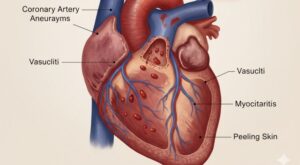Anxiety Among Kids is on the Rise: What Every Parent Needs to Know

“My child is just shy.”
“It’s just a phase.”
Many parents brush off signs of anxiety in children, assuming it’s temporary or harmless. But global health experts say otherwise. Anxiety disorders among kids are rising — silently and steadily — becoming one of the most common mental health issues affecting young minds today.
The Alarming Numbers
According to the World Health Organisation (WHO), anxiety disorders are among the top contributors to mental health-related illnesses in children and adolescents worldwide. A large-scale meta-analysis published in JAMA Paediatrics (2021) found that anxiety and depression doubled among children and teens during the COVID-19 pandemic, with anxiety rates touching nearly 20% globally.
But even before the pandemic, paediatric psychologists were witnessing a steady climb in anxiety diagnoses among children as young as 6 or 7 years old.
Why Are More Kids Experiencing Anxiety?
The causes are complex and layered:
Academic Pressure
Today’s competitive schooling and early exposure to exams, ranks, and comparisons fuel constant stress.
Digital Overload
Excess screen time, exposure to negative news, cyberbullying, and social media comparison contribute to heightened anxiety.
Family & Environmental Factors
Marital conflicts, parental stress, financial insecurities, or experiencing a traumatic event can trigger anxiety in children.
Biological Predisposition
Genetics and neurochemical imbalances, such as dysregulated cortisol (the stress hormone), can make some children more prone to anxiety.
Global Events
Natural disasters, wars, or pandemics indirectly increase stress levels in households, affecting children’s emotional wellbeing.
How to Spot Anxiety in Children
Unlike adults, children often struggle to articulate their emotions. Watch out for these signs:
🔸 Excessive worry or fear (even over minor issues)
🔸 Trouble sleeping or nightmares
🔸 Frequent stomachaches, headaches, or unexplained physical complaints
🔸 Avoidance of school, social activities, or new experiences
🔸 Irritability, restlessness, or being easily fatigued
🔸 Sudden clinginess or separation anxiety
Note: Symptoms vary with age. Younger children may display more physical symptoms, while older kids may show behavioural changes or academic struggles.
What Does Science Say?
Research confirms that chronic anxiety in childhood can:
✔ Alter brain regions like the amygdala and prefrontal cortex, responsible for fear processing and decision-making
✔ Impact cognitive development and academic performance
✔ Increase the risk of depression, substance abuse, and social withdrawal in adolescence or adulthood
However, early intervention significantly improves outcomes. Cognitive Behavioural Therapy (CBT), mindfulness practices, parental support, and in some cases, medication under expert supervision, help reduce anxiety symptoms effectively.
The Lancet Child & Adolescent Health (2022) emphasised integrating mental health screenings into routine paediatric care to catch anxiety disorders early.
Benefits of Mild Anxiety: Backed by Psychology
While anxiety is often portrayed negatively, mild levels of anxiety can actually serve as a protective and motivating force. According to research from the Yerkes-Dodson Law (a well-established psychological principle), performance improves with increased arousal or stress—but only up to a certain point. Beyond that, excessive anxiety becomes harmful. But mild anxiety? It can be beneficial.
Scientifically Recognized Benefits of Mild Anxiety
Improved Focus & Alertness
Mild anxiety heightens your senses and improves attention to detail, which can enhance problem-solving, especially in situations that require vigilance (American Psychological Association).
Motivation to Prepare
Anticipatory anxiety can push individuals to plan ahead, meet deadlines, or prepare thoroughly for events like exams, presentations, or interviews (Harvard Health Publishing).
Risk Awareness & Caution
Mild anxiety increases risk perception, making people more cautious in dangerous or unfamiliar environments, thus reducing reckless behaviors (National Institute of Mental Health).
Emotional Resilience Building
Experiencing and managing low-level anxiety strengthens coping mechanisms over time, enhancing emotional resilience.
Early Warning System
Anxiety serves as an internal alarm, alerting us to potential problems or challenges—enabling proactive action before issues escalate.
Practical Ways to Support Your Child
Here are evidence-based steps every parent can take:
Encourage Open Conversations — Normalise discussions about emotions
Limit Screen Time — Promote real-life social interactions
Model Calm Behaviour — Children learn stress management by observing adults
Promote Mindfulness & Play — Activities like yoga, breathing exercises, and outdoor play reduce anxiety
Seek Professional Help — Early therapy can empower kids with coping strategies
Anxiety among children is real, rising, and requires attention — not dismissal. By staying informed, fostering supportive environments, and accessing the right resources, we can help our children navigate these turbulent emotions and build resilience for life.
Because protecting their mental health today shapes the confident adults of tomorrow.
References:
- Racine N, et al. (2021). Global prevalence of depressive and anxiety symptoms in children and adolescents during COVID-19. JAMA Paediatrics. [1]
- WHO. (2021). Mental health and COVID-19: Early evidence of the pandemic’s impact.[2]
- The Lancet Child & Adolescent Health. (2022). Prioritising mental health screening in paediatric populations.[3]
For trusted resources and mental health support, follow nellikka.life – Your Companion for Well-being.




